Iceberg Lettuce Salad
Shrimp Salad...With Iceberg Lettuce
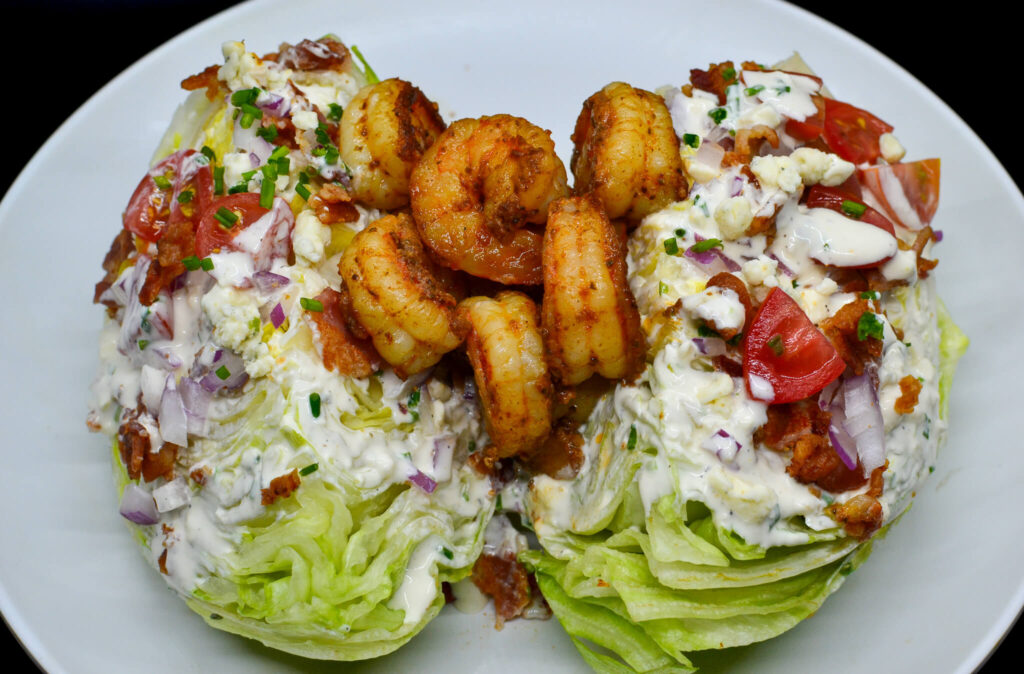
What Is Iceberg Lettuce Salad?
Iceberg lettuce salad, a staple in many salad recipes, is typically made with iceberg lettuce as the primary ingredient. Known also as crisphead lettuce, this variety is recognized by its large, round head and crisp, pale-green leaves.
A well-known recipe using iceberg lettuce is the wedge salad. It involves slicing a head of iceberg lettuce into large, wedge-shaped pieces. These wedges are then topped with ingredients such as blue cheese dressing, bacon, tomatoes, and chives, creating a delicious and visually appealing dish.
Ingredients For Iceberg Lettuce Salad


Produce
1 Head of Iceberg Lettuce
1 Red Onion
1/2 Cup Cherry Tomatoes
1 Lemon
Chives
Refrigerated
1/3 Cup Buttermilk
4 Tbsp Mayonnaise
4 Tbsp Sour Cream
2.5 Ounces Blue Cheese

Grocery
2 tsp Red Wine Vinegar
1 tsp Worcestershire Sauce

Meat
8 Slices of Bacon
1 Pound Shrimp

Spices
2 Tbsp Old Bay Seasoning
1 Tsp Mustard Powder
1 Tsp Salt
1 Tsp Black Pepper
How To Make Iceberg Lettuce Salad
Step 1
Make Blue Cheese Dressing

Blue cheese dressing combines different flavors and textures to make a well-balanced and adaptable sauce. The main ingredients are blue cheese, mayonnaise, and sour cream. Blue cheese brings a unique, strong, and tangy taste that is the heart of the dressing. But this taste can be too much if not balanced right. That’s where mayonnaise and sour cream help. Their creamy texture and mild flavor soften the strong taste of the blue cheese, making sure it’s not too intense.

Adding buttermilk to blue cheese dressing is a great idea because it improves both its taste and texture. The tangy flavor of buttermilk goes well with the strong taste of blue cheese, making the dressing more complex and rich. Buttermilk’s acidity not only enhances the flavor but also balances the richness of mayonnaise and sour cream.
Texture-wise, buttermilk is thinner than mayonnaise and sour cream. This helps make the dressing more pourable, perfect for drizzling over salads or other dishes. Also, the acidity in buttermilk helps break down the blue cheese, creating a smoother, more even mix.
Add 1/3 Cup of Buttermilk, along with 1 tsp of Worcestershire sauce and 2 tsp of red wine vinegar.

Next, add 2 minced garlic cloves, and freshly squeezed lemon juice from half the lemon.
Garlic, with its strong, distinct flavor, is an excellent addition to the dressing. It deepens the flavor, matching well with the boldness of blue cheese and balancing the creaminess of mayonnaise, sour cream, or buttermilk. If minced or crushed, garlic also adds a subtle texture difference to the dressing.
Lemon juice brings a bright, citrusy touch to the mix. Its acidity cuts through the richness, keeping the dressing from being too heavy. It also boosts the tanginess of both the blue cheese and buttermilk, making the dressing’s flavors livelier. Plus, lemon juice’s acidity helps keep the dressing fresh for longer.

dding chives to blue cheese dressing greatly enhances it in various ways. Chives have a mild, onion-like taste that pairs well with the tangy, strong flavor of blue cheese. They add an extra layer of complexity without overpowering the existing flavors.
The subtle onion flavor of chives provides a nice contrast to the rich and creamy elements of the dressing, improving the overall taste. Visually, the bright green of chives adds color and appeal to the dressing, making it and the dishes it’s used in look more appetizing.
Chives also bring a slight crunch, adding a new texture to the otherwise creamy dressing, which enhances the overall eating experience.

Once you’ve added the garlic and lemon, season the dressing with:
- 1 tsp salt
- t tsp black pepper
- 1 tsp mustard powder
Adding mustard powder to blue cheese dressing is really beneficial. It makes the taste better and more interesting because it’s tangy and a bit spicy, which goes well with the blue cheese flavor.
Mustard powder also helps mix everything together smoothly. It keeps the dressing from separating, so it stays nice and creamy. This is great if you’re not using much oil in the dressing.
The little bit of heat and tang from the mustard powder also helps balance out the creamy mayonnaise, sour cream, or buttermilk, making the dressing’s taste more complex and enjoyable.
Also, adding a bit of salt and pepper makes the dressing’s flavor even better, giving it more depth and a nice seasoning touch.

Lastly, add 2.5 ounces of blue cheese crumbles, which I used Belgioioso because I like their name.
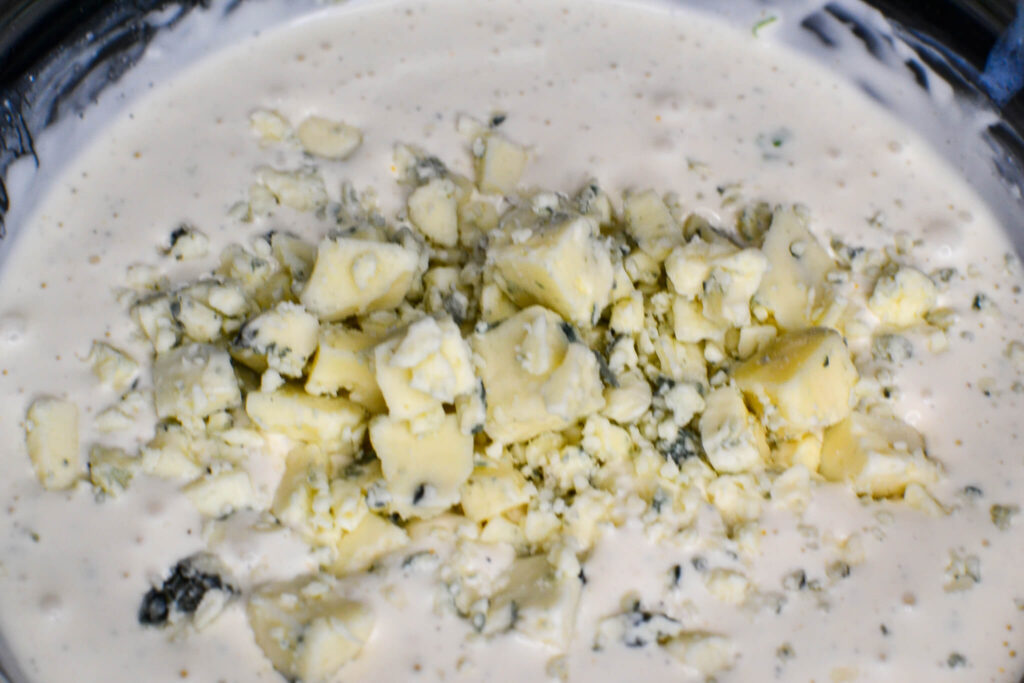
Choosing to use 2.5 ounces of blue cheese in a dressing is based on a few things like how much you’re making, getting the flavor just right, and personal taste. Blue cheese has a strong, sharp flavor that can take over a dish if you use too much.
When you add it to a dressing, you want enough to taste its unique flavor but not so much that it overpowers everything else. Getting this balance right is key to a good-tasting dressing. For a typical batch of dressing, 2.5 ounces usually works well, giving a noticeable but not overwhelming blue cheese taste.
Finally, it’s all about what you like. Some might want less blue cheese for a milder dressing, while others might add more for a stronger flavor.
Step 2
Prep Produce

Iceberg lettuce salads often include some very nice crisp lettuce. In particular, they utilize crisp iceberg lettuce for that fresh, crunchy texture.
The first thing you need to do is remove the core.
- Hold the lettuce: First, you’ll want to hold the head of lettuce in both hands with the core facing down.
- Hit the core: Next, sharply hit the core directly onto a hard surface like a cutting board or kitchen counter. This should loosen the core.
- Twist and remove: Then, twist the core and pull it out. It should come out with ease if it was loosened properly in the previous step.
- Check and clean: Finally, check for any remaining hard parts of the core and remove them. Also, make sure to remove any brown or wilted outer leaves. You can now proceed to wash and prepare your lettuce as desired.
It’s a straightforward and efficient process, which doesn’t require a knife and helps keep the lettuce head intact for further preparation.

After you’ve removed the core, place the iceberg lettuce on a cutting board with the core side facing down.
Once your lettuce is face down, using a sharp knife, cut the lettuce in half from top to bottom. Ensure your knife is sharp enough to make a clean cut and doesn’t bruise the lettuce.
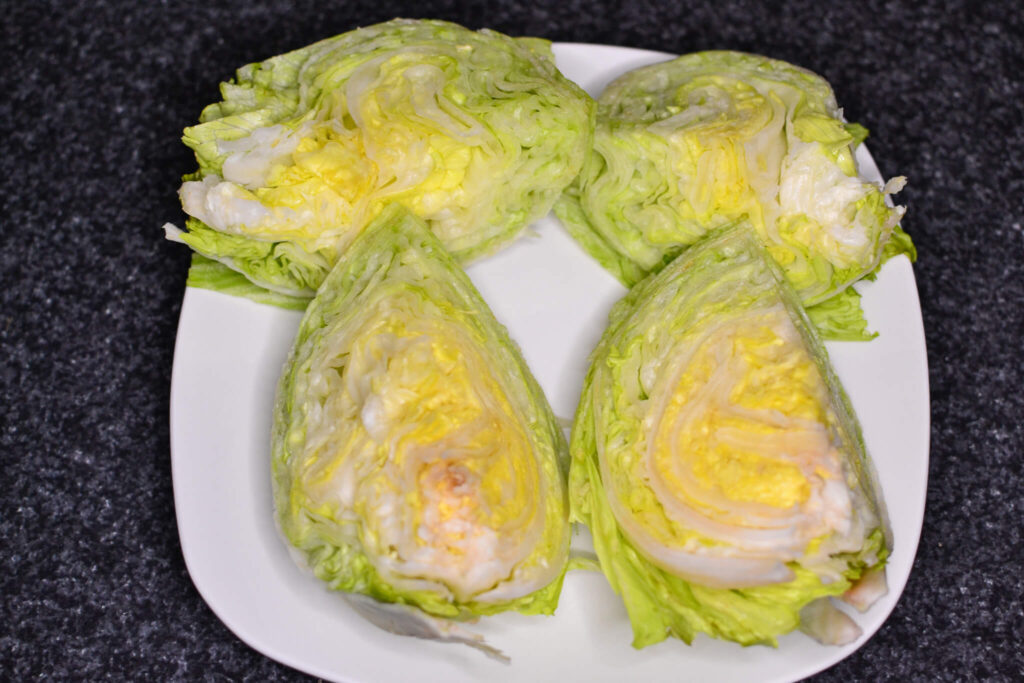
Once the lettuce is in half, cut each half of the lettuce again from top to bottom, creating four equal-sized quarters.
Depending on how you plan to use it, you might want to rinse each quarter under cold water and pat dry with a paper towel or use a salad spinner to remove any excess water.
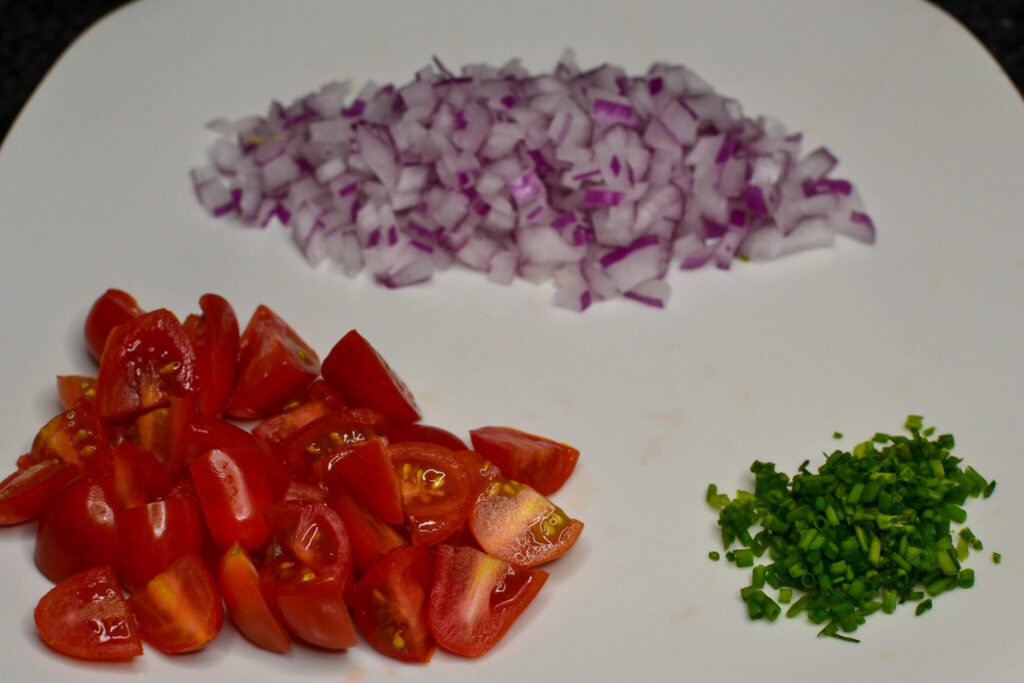
Lastly, you’ll need cut up your red onions, cherry tomatoes, and chives. Set aside while you cook the shrimp.
Step 3
Cook Shrimp

Adding shrimp to an iceberg salad is a great idea for many reasons and is liked by lots of salad lovers.
First, shrimp is a lean protein, which makes a simple salad more filling and nutritious. It’s perfect for those who want to keep an eye on their calories but still enjoy a hearty meal.
Second, shrimp has a unique, slightly sweet taste that goes really well with the crisp, fresh flavor of iceberg lettuce. This mix of flavors makes the salad taste even better. Plus, the texture of shrimp is firm but tender, which is a nice change from the crunch of the lettuce, adding different textures to your meal.
Lastly, shrimp is really versatile. You can cook it in many ways – grilling, boiling, or sautéing – and each method gives it a different flavor.
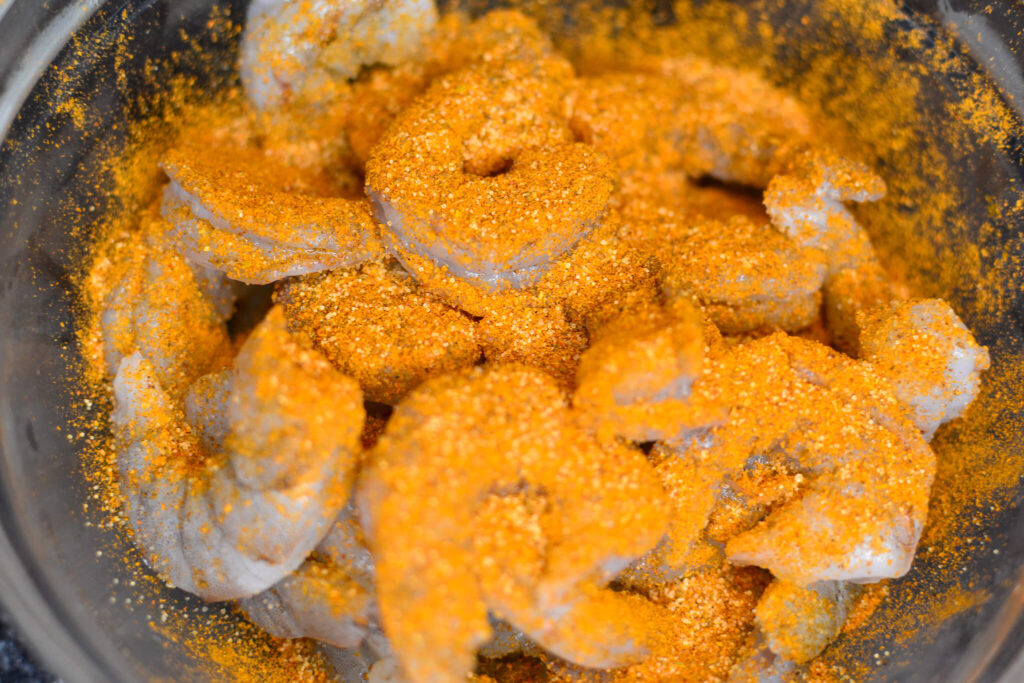
Seasoning shrimp with Old Bay seasoning is an excellent idea due to several reasons:
- Flavor Match: Old Bay seasoning is a blend of herbs and spices, including celery salt, black pepper, crushed red pepper flakes, and paprika, among others. These flavors pair exceptionally well with the natural sweetness of shrimp, enhancing its taste without overpowering it.
- Versatility: Old Bay is versatile and complements not only seafood but also salads and other elements you might have in your dish. Its complex flavor profile adds depth and character to the overall dish.
- Ease of Use: It’s a pre-mixed seasoning blend, so it’s straightforward and quick to use. This is particularly useful when you want to add a lot of flavor to your shrimp without the need for measuring and mixing multiple individual seasonings.
- Tradition: Old Bay seasoning is traditionally used with seafood, especially in the Mid-Atlantic and Southern regions of the United States. Using it with shrimp follows this tradition and is an acknowledgment of this culinary heritage.
Therefore, the use of Old Bay seasoning not only enhances the taste of the shrimp but also adds complexity to the overall dish, making it an excellent choice for seasoning.

Add 2 tbsp of old baby seasoning to the shrimp, mixing thoroughly.

Cook the shrimp on medium-high heat on each side for roughly 2-3 minutes per side.
Step 4
Bake Bacon

The baking time for bacon can vary depending on the thickness of the bacon and how crispy you like it. Here’s a general guideline for baking bacon in the oven:
- Preheat your oven: First, preheat your oven to 400 degrees Fahrenheit (about 200 degrees Celsius).
- Arrange the bacon: Line a baking sheet with aluminum foil (for easier cleanup) and place a wire rack on top. Arrange the bacon strips in a single layer on the wire rack.
- Bake the bacon: Bake the bacon in the preheated oven for about 15 to 20 minutes. Thin bacon will likely be done closer to the 15-minute mark, while thicker bacon will need closer to 20 minutes or even a bit longer.
- Check the bacon: Keep a close eye on the bacon in the final few minutes, as it can go from perfect to burnt rather quickly. The bacon should be a nice golden brown color when it’s done.
- Drain the bacon: Once done, carefully remove the baking sheet from the oven (it will be hot, and there will be hot grease in the foil), and use tongs to transfer the bacon strips to a plate lined with paper towels to drain and cool.
Remember, oven temperatures can vary, so it’s always a good idea to check the bacon frequently to prevent it from burning.
Step 5
Enjoy Your Iceberg Lettuce Salad!

Drizzle your homemade blue cheese dressing over the iceberg lettuce, followed by the bacon, onion, tomato, chives, and shrimp. Add an extra splash of blue cheese dressing, sprinkle on some crumbled blue cheese for an added kick, and enjoy!

Titanic

Inspiration
The Titanic Collision

More About Iceberg Lettuce Salad

Iceberg Lettuce Salad
Ingredients
- 1 head Iceberg Lettuce
- 1 Red Onion
- 1/2 cup Cherry Tomatoes
- Chives
- Parsley
- 1/3 cup Buttermilk
- 4 tbsp Mayonnaise
- 4 tbsp Sour Cream
- 2.5 oz Crumbled Blue Cheese
- 2 tsp Red Wine Vinegar
- 1 tsp Worcestershire Sauce
- 8 slices Bacon
- 1 pound Shrimp
- 2 tbsp Old Bay Seasoning
- 1 tsp Mustard Powder
- 1 tsp Salt
- 1 tsp Black Pepper
- 1 tsp Garlic Powder
- 1 tsp Onion Powder
- 1 tsp Paprika
Instructions
Make Blue Cheese Dressing
- In a small bowl, whisk together 1/3 cup buttermilk, 4 tbsp mayonnaise, and 4 tbsp sour cream until smooth.
- Stir in 1 tbsp Worcestershire sauce and 2 tsp red wine vinegar.
- Add 2 minced garlic cloves and juice from half a lemon. Whisk to combine.
- Season with 1 tsp salt, 1 tsp black pepper, and 1 tsp mustard powder. Mix thoroughly.
- Fold in 2.5 oz crumbled blue cheese and chopped chives (optional).
- Refrigerate for at least 30 minutes.
Prep Produce
- Remove the core from 1 head of iceberg lettuce. Cut into quarters, then chop into bite-sized pieces. Dry thoroughly using a salad spinner or paper towels.
- Thinly slice 1/2 red onion and halve 1/2 cup cherry tomatoes.
- Finely chop chives and parsley for garnish (optional).
Cook Shrimp
- Toss 1 lb peeled and deveined shrimp with 2 tbsp Old Bay seasoning.
- Heat a skillet over medium-high heat. Add a drizzle of oil if necessary.
- Cook shrimp for 2-3 minutes per side until pink and opaque. Set aside.
Cook Bacon
- Preheat oven to 375°F (190°C). Line a baking sheet with aluminum foil and place a wire rack on top.
- Arrange 8 slices of bacon in a single layer on the rack.
- Bake for 15-20 minutes until crispy. Let cool, then crumble.
Assemble the Salad
- In a large bowl, combine chopped iceberg lettuce, sliced red onions, halved cherry tomatoes, cooked shrimp, and crumbled bacon.
- Drizzle with blue cheese dressing and toss gently to coat.
- Garnish with chopped chives and parsley (optional).
Iceberg lettuce, originally known as “crisphead lettuce,” became popular in the United States in the early 20th century. It got its now well-known name “iceberg” from the way it was transported across the country before the days of refrigerated trucks. The lettuce heads were packed in ice to keep them fresh during transport, forming an “iceberg” around the lettuce.
Iceberg lettuce salads, as we know them, have been a staple in American cuisine for decades. The classic wedge salad, a quarter head of iceberg lettuce often served with blue cheese dressing, bacon, and tomatoes, is believed to have been popular since at least the 1950s or 60s. It was a standard menu item in steakhouses and restaurants.

